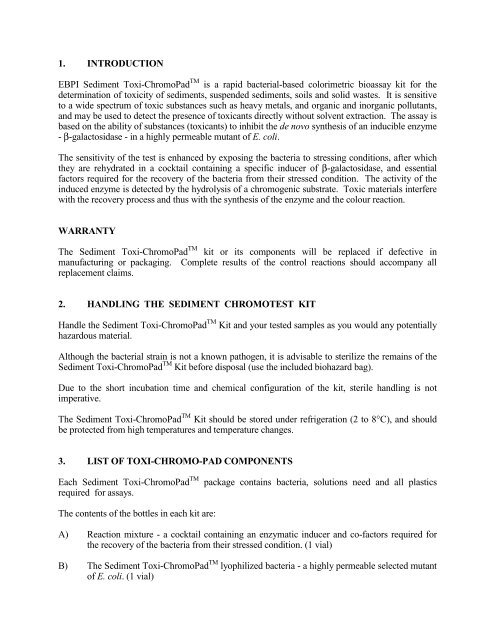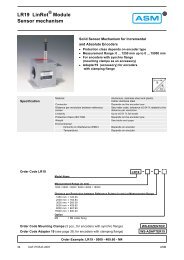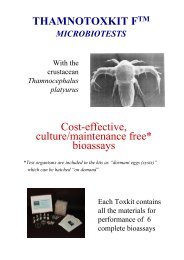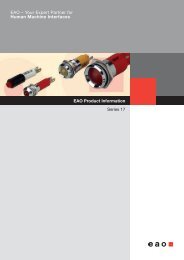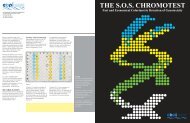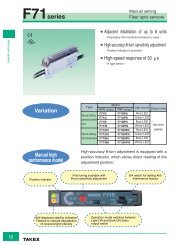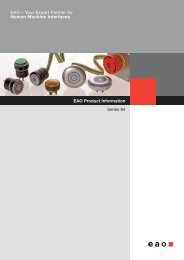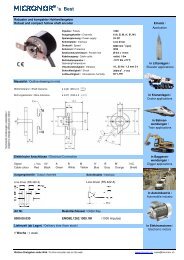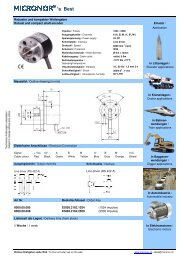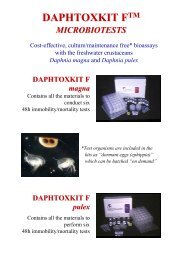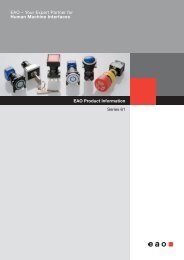1. INTRODUCTION EBPI Sediment Toxi-ChromoPad is a rapid ...
1. INTRODUCTION EBPI Sediment Toxi-ChromoPad is a rapid ...
1. INTRODUCTION EBPI Sediment Toxi-ChromoPad is a rapid ...
Create successful ePaper yourself
Turn your PDF publications into a flip-book with our unique Google optimized e-Paper software.
<strong>1.</strong> <strong>INTRODUCTION</strong><br />
<strong>EBPI</strong> <strong>Sediment</strong> <strong>Toxi</strong>-<strong>ChromoPad</strong> TM <strong>is</strong> a <strong>rapid</strong> bacterial-based colorimetric bioassay kit for the<br />
determination of toxicity of sediments, suspended sediments, soils and solid wastes. It <strong>is</strong> sensitive<br />
to a wide spectrum of toxic substances such as heavy metals, and organic and inorganic pollutants,<br />
and may be used to detect the presence of toxicants directly without solvent extraction. The assay <strong>is</strong><br />
based on the ability of substances (toxicants) to inhibit the de novo synthes<strong>is</strong> of an inducible enzyme<br />
- β-galactosidase - in a highly permeable mutant of E. coli.<br />
The sensitivity of the test <strong>is</strong> enhanced by exposing the bacteria to stressing conditions, after which<br />
they are rehydrated in a cocktail containing a specific inducer of β-galactosidase, and essential<br />
factors required for the recovery of the bacteria from their stressed condition. The activity of the<br />
induced enzyme <strong>is</strong> detected by the hydrolys<strong>is</strong> of a chromogenic substrate. <strong>Toxi</strong>c materials interfere<br />
with the recovery process and thus with the synthes<strong>is</strong> of the enzyme and the colour reaction.<br />
WARRANTY<br />
The <strong>Sediment</strong> <strong>Toxi</strong>-<strong>ChromoPad</strong> TM kit or its components will be replaced if defective in<br />
manufacturing or packaging. Complete results of the control reactions should accompany all<br />
replacement claims.<br />
2. HANDLING THE SEDIMENT CHROMOTEST KIT<br />
Handle the <strong>Sediment</strong> <strong>Toxi</strong>-<strong>ChromoPad</strong> TM Kit and your tested samples as you would any potentially<br />
hazardous material.<br />
Although the bacterial strain <strong>is</strong> not a known pathogen, it <strong>is</strong> adv<strong>is</strong>able to sterilize the remains of the<br />
<strong>Sediment</strong> <strong>Toxi</strong>-<strong>ChromoPad</strong> TM Kit before d<strong>is</strong>posal (use the included biohazard bag).<br />
Due to the short incubation time and chemical configuration of the kit, sterile handling <strong>is</strong> not<br />
imperative.<br />
The <strong>Sediment</strong> <strong>Toxi</strong>-<strong>ChromoPad</strong> TM Kit should be stored under refrigeration (2 to 8°C), and should<br />
be protected from high temperatures and temperature changes.<br />
3. LIST OF TOXI-CHROMO-PAD COMPONENTS<br />
Each <strong>Sediment</strong> <strong>Toxi</strong>-<strong>ChromoPad</strong> TM<br />
required for assays.<br />
package contains bacteria, solutions need and all plastics<br />
The contents of the bottles in each kit are:<br />
A) Reaction mixture - a cocktail containing an enzymatic inducer and co-factors required for<br />
the recovery of the bacteria from their stressed condition. (1 vial)<br />
B) The <strong>Sediment</strong> <strong>Toxi</strong>-<strong>ChromoPad</strong> TM lyophilized bacteria - a highly permeable selected mutant<br />
of E. coli. (1 vial)
C) Rehydration solution - a solution to hydrate the bacteria. (1 vial)<br />
D) Chromogenic pads - contain blue chromogenic substrate. (4 pads)<br />
E) D<strong>is</strong>posable plastic pipets. (14 pipets)<br />
F) D<strong>is</strong>posable test tubes. (24 tubes)<br />
G) Plastic bag for incubation. (1 bag)<br />
4. USING ONE SEDIMENT CHROMOTEST KIT<br />
Each <strong>Sediment</strong> <strong>Toxi</strong>-<strong>ChromoPad</strong> TM package contains all the material necessary to test four samples,<br />
in five two-fold dilutions each, for semi-quantitative analys<strong>is</strong>. For qualitative screening, you may<br />
test up to 20 samples (with just one dilution) with the ex<strong>is</strong>ting reagents (but additional pipets may be<br />
required).<br />
5. SEDIMENT TOXI-CHROMOPAD TM PROCEDURE<br />
Th<strong>is</strong> chapter describes the steps of the <strong>Sediment</strong> <strong>Toxi</strong>-<strong>ChromoPad</strong> TM procedure. Figures 1 and 2<br />
illustrate the procedure. Be sure to include a control with each test.<br />
Before you start, set up series of d<strong>is</strong>posable test tubes. For each sample tested you will require five<br />
test tubes, plus one for control.<br />
5.1 Rehydrate the bacteria in Bottle B with the solution in Bottle C. Keep both bottles cold<br />
before mixing. Remove the seals and stoppers from the two bottles and immediately<br />
transfer the medium from Bottle C to Bottle B. Mix well by gently shaking. Leave at room<br />
temperature for fifteen minutes.<br />
5.2 Transfer <strong>1.</strong>0 ml (or up to mid-way between the red and blue lines on the plastic pipet) of<br />
bacterial suspension from Bottle B into 9.3 ml of Reaction Mixture in Bottle A.<br />
5.3 Keep the bacteria reaction-mixture in (Bottle A) at room temperature for about ten minutes<br />
before d<strong>is</strong>pensing <strong>1.</strong>0 ml (or up to the blue line on the plastic pipet) of the bacteria reaction<br />
mixture into the first tube, and 0.5 ml (or up to the red line on the plastic pipet) into the<br />
remaining tubes (two to five).<br />
5.4 Place 0.5 g of wet sediment sample into the first tube and mix thoroughly.<br />
5.5 Transfer 0.5 ml (or up to the red line on the plastic pipet) of the bacteria-sediment mixture<br />
into the second tube, second to third, third to fourth and fourth to fifth.<br />
5.6 After mixing tube 5, 0.5 ml (or up to the red line on the plastic pipet) of mixture <strong>is</strong><br />
d<strong>is</strong>carded.<br />
5.7 Before each transfer, the bacteria-sediment mixture <strong>is</strong> hand-shaken vigorously or vortex.
Make sure to transfer the suspended portion of solid particles. Cut off the pipet tips if<br />
necessary.<br />
5.8 Place 0.5 ml (or up to the red line on the plastic pipet) of bacterial suspension into the<br />
control tube.<br />
5.9 All tubes are then incubated for two hours at 37°C.<br />
5.10 After the two-hour incubation, hand-mix vigorously each tube again immediately before<br />
transferring a small drop from each tube onto the chromogenic pad (see Figure 2).<br />
For liquids and light solids (e.g., sand), continue with Steps 5.11 to 5.15, as follows:<br />
5.11 Cover the petri d<strong>is</strong>hes and incubate at 37°C for one hour, or until a v<strong>is</strong>ible blue colour<br />
develops in the control (central) blot.<br />
5.12 After the incubation, wash off the solids from the pad with water using a squirt bottle.<br />
5.13 Check the reverse side of each transfer spot for a blue colour development.<br />
5.14 If the sample <strong>is</strong> toxic, no blue colour will develop and if the sample <strong>is</strong> non-toxic, a blue<br />
colour will develop under the sample spot.<br />
For all other solids, continue with Steps 5.11 to 5.14, as follows:<br />
5.11 Cover the petri d<strong>is</strong>hes and incubate at 37°C overnight (or ≥ ten hours).<br />
5.12 After the incubation, was off the solids from the pad with water using a squirt bottle.<br />
5.13 Check the reverse side of each transfer spot for a blue colour development.<br />
5.14 If the sample <strong>is</strong> toxic, no blue colour will develop and if the sample <strong>is</strong> non-toxic, a blue colour<br />
will develop under the sample spot.<br />
6. ANALYSIS OF THE RESULTS<br />
Check the colour density appearing in the reverse side of each transfer spot on the pad. High<br />
toxicant concentrations may not have any colour due to toxicity. As the material <strong>is</strong> diluted out,<br />
toxicity <strong>is</strong> reduced and colour density will increase up to the maximal level of the controls.<br />
Results can be recorded by determining the highest sample concentration which gave complete<br />
inhibition, i.e., no colour development. Th<strong>is</strong> <strong>is</strong> the sample's Effective Concentration 100 (EC 100 )<br />
value expressed in percent units. For example, if no colour <strong>is</strong> developed in the second dilution, but<br />
some colour develops in the third dilution, the EC 100 value <strong>is</strong> 25%.
7. REFERENCES<br />
Kwan, K.K. 1993. Direct solid phase toxicity testing procedure. Environ. <strong>Toxi</strong>col. Wat. Qual. 8:<br />
345-350.<br />
Kwan, K.K. 1993. Direct toxicity assessment of solid phase samples using the <strong>Toxi</strong>-Chromotest<br />
kit. Environ. <strong>Toxi</strong>col. Wat. Qual. 8: 345-350.<br />
Reinhartz, A., L. Lampert, M. Herzberg and F. F<strong>is</strong>h. 1987. A new, short-term, sensitive bacterial<br />
assay kit for the detection of toxicants. <strong>Toxi</strong>c. Assess. 2: 193-206.


